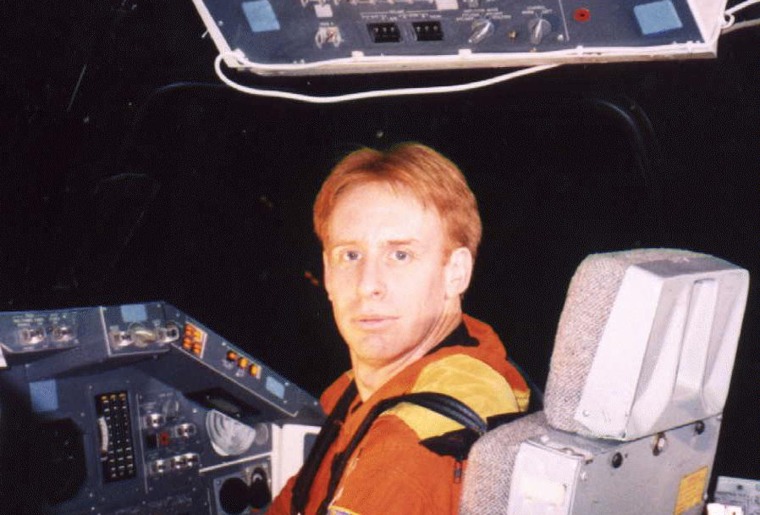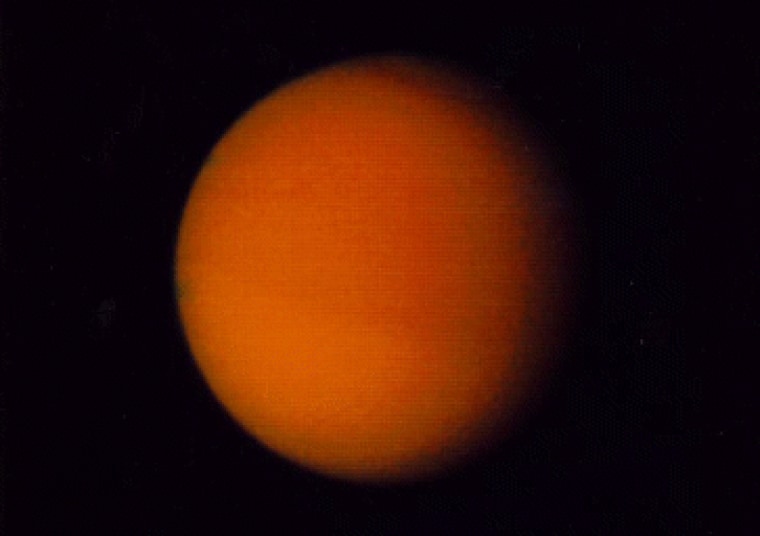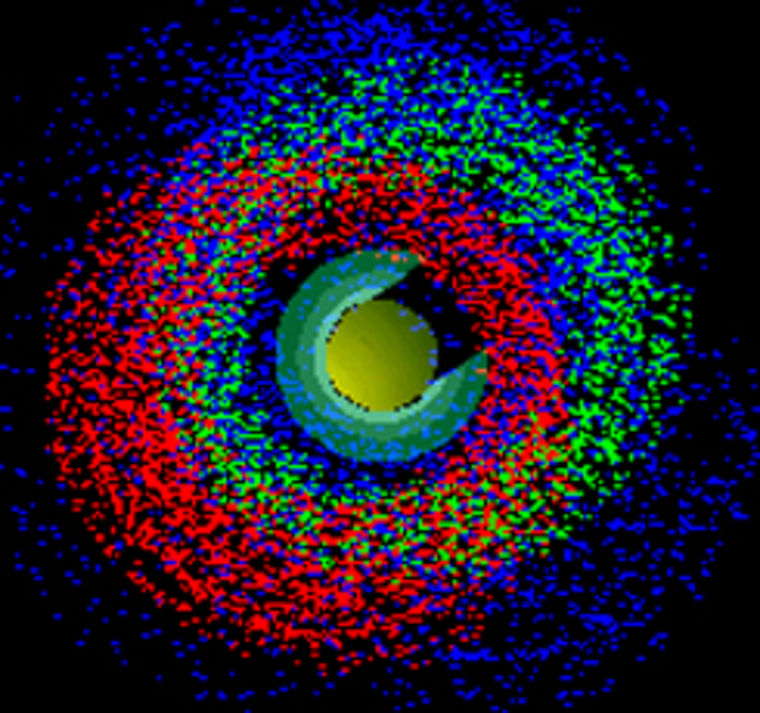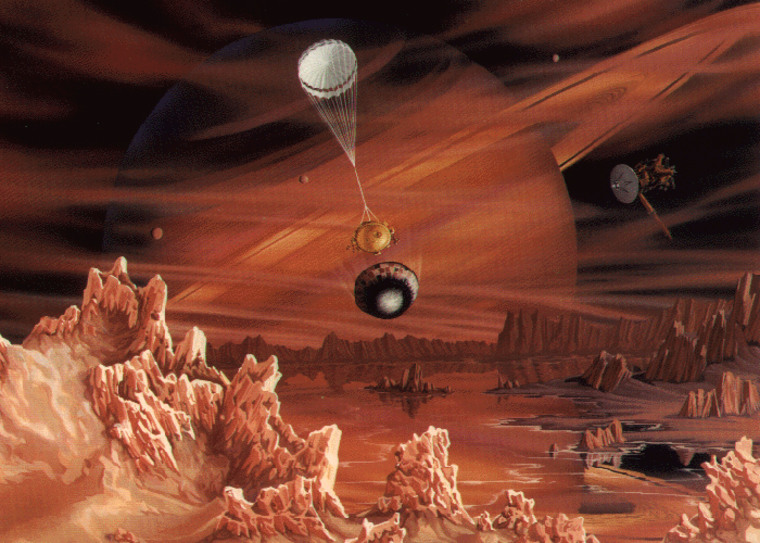The curtain rose this week on the Cassini mission, an astronomical extravaganza with Saturn at center stage, and the planet’s rings and moons as supporting players.
This production was years in the making: After more than a decade of planning, NASA launched the 6-ton spacecraft back in 1997, setting the stage for Wednesday’s opening night. The show promises to have a nice long run, sending back imagery for at least the next four years.
But Cassini isn’t just about pretty pictures of rings and cloud patterns. The mission is really a mystery story — and one of the lead scriptwriters is Kevin Grazier, a science planning engineer at NASA’s Jet Propulsion Laboratory in Pasadena as well as science investigator for Cassini’s imaging team.
For Grazier, it’s finally showtime.
He's familiar with the feeling: In addition to his duties on the Cassini mission, Grazier has been a science adviser for Hollywood science-fiction projects such as “Battlestar Galactica” and “The Great War of Magellan.”

He also serves as a planetarium lecturer at Los Angeles’ Griffith Observatory and an adjunct astronomy professor at Santa Monica College.
Even back in March, Grazier was buzzing during an interview at JPL. “I’ve been up for a long time, so I’m highly caffeinated right now,” he explained.
So when Grazier was asked to run through the main mysteries that Cassini could unravel, he served up the scientific equivalent of a triple shot of espresso. Here are the plot twists Grazier will be watching for as the Cassini mission unfolds:
What’s Titan like?
Saturn’s largest moon, Titan is also the second-biggest moon in the solar system (Jupiter’s Ganymede is first). In December, Cassini is due to send the European Space Agency’s Huygens probe on a trip that will take it through Titan’s atmosphere.
“Titan is one of the big targets of this mission,” Grazier said. “When Voyagers 1 and 2 flew by in the early ’80s, they imaged the moon. It’s the only moon in the solar system with a thick atmosphere. At the surface of that moon, the atmospheric pressure is about one and a half times greater than Earth’s — it’s about equal to scuba diving at 15 feet [4.5 meters].”

Titan's atmosphere, like Earth's, is predominantly composed of nitrogen. But there are thick orangish clouds of hydrocarbon smog through which conventional cameras cannot see. "It looks like a basketball hovering in space," Grazier said. "Therefore, Titan has the largest unmapped solid surface in the solar system.
“Now, we think with the judicious use of filters on our imaging system, we can see that surface," he said. "But so what if we can’t? Because, like the Magellan mission at Venus, we can use our main dish as a radar mapper. And that atmosphere will certainly be transparent to radar. One way or another, we’re going to see this surface.
“Titan also has an atmosphere that is similar, we believe, to the atmosphere that existed on Earth which eventually led to life. The phrase you often hear is ‘early Earth in a deep freeze.’ So therefore, the Huygens probe that descends through that atmosphere will do compositional measurements. What is the atmosphere composed of? We’ll look for nitrogen, hydrocarbon clouds — what else? We also think that we may find lakes of liquid ethane or methane — liquid natural gases. So Titan is a big question mark. It’s going to be exciting, no matter what.”
How did Saturn get its rings?
The rings are what make Saturn stand out from the solar system crowd, but there is much astronomers still don't know about their composition and origins. "Are those rings old or new? We think they're new," Grazier said.
Of course, "new" is a relative term: One theory is that the rings are leftovers from the creation of the planet, more than 4 billion years ago. Another theory suggests that the rings arose when an object or objects orbiting the planet broke up — say, 100 million years ago. That's "new" in Grazier's book.
Then again, it could well be that both theories are required — that Saturn's original rings had to be periodically replenished by fresh interplanetary debris. A detailed analysis of the rings' composition should help determine which scenario comes closest to the truth.
"For the most part, we avoid the rings like the plague," Grazier said. "They’re a collision hazard. [The particles] range from dust-sized to mountain-sized, and we avoid that. The closest we get to the rings is the first thing we do there. Orbital insertion, above the B ring, fire our engines for 96.4 minutes ... and then, after we’ve done that, we look down on the rings because it’s the closest we get. After that, we avoid them."
What's inside Enceladus?
For years, scientists have marveled over the moons of Jupiter: for example, Io, which is more volcanically active than Earth; and Europa, which may well have an ice-covered ocean deeper than any sea on Earth. If you like Io and Europa, you just might grow fond of Enceladus, an icy, inner moon of Saturn. Grazier suspects that ice spewing from Enceladus could explain the existence of Saturn's outermost ring, known as the E ring.

Despite what Grazier said about avoiding rings like the plague, the E ring is so wide and diffuse that Cassini has no choice but to fly through it.
"It’s huge! A monster!" he said. "But it’s made of micron-sized ice crystals. Could that be the Saturn equivalent of the Io torus? Are you familiar with the Io torus? Io … volcanic world, volcanoes spewing out sulfur, sulfur gets ionized, excited, and you get a yellow glow. Well, Enceladus may have ice volcanoes. ... If we find, on Enceladus, ice volcanoes from internal heating, similar to Io, we may explain the E ring. ...
"If Enceladus is the source of the E ring and there is ice volcanism, then there is internal melting — and hence, if not liquid water, then slush," Grazier said. The moon is probably too cold to be hospitable to life, he said. Nevertheless, if there is evidence for water or slush beneath Enceladus' icy shell, that could get the heart of an astrobiologist beating a little faster.
How does the magnetic field work?
"Interestingly enough, Saturn is the only planet where magnetic north and true north are synonymous," Grazier said. "Certainly the magnetic field is generated in the interior of the planet. Even though it’s a gas planet and has a very different cross-section from Earth, likely the mechanisms for generating that field are similar.
"But there was a fellow — you may have heard of him, his name was Albert Einstein — who said that there were three great problems left in physics. And one of them was determining exactly how Earth’s magnetic field is generated. That’s still a big mystery, and it’s the same thing for a gas planet. We’re still unsure. So how is it generated? We have a magnetometer on our spacecraft that will measure the orientation and strength of the magnetic field."
Strangely enough, Saturn's magnetic field also could help Cassini study electrically charged particles that are stirred up into space from the planet's moons, Grazier said.
"That magnetic field will trap certain ions. We have a dust detector that determines the composition of the [particles] that impact the spacecraft. So sometimes we can actually sample the surfaces of these moons directly," he said.
Mysteries known and unknown
Many more mysteries await: Exactly how do Saturn's "shepherding moons" keep the rings in line? What are the dynamics behind the planet's cloud patterns and clashing storms? Underneath all those clouds, just how long does it take Saturn to rotate?
And then there are the unexpected mysteries that astronomers will discover once Cassini gets into its role. After years of preparation, Grazier and his colleagues on the Cassini cast are looking forward to the scientific improvisation.
"It's going to be fun to actually watch these things," he said.
